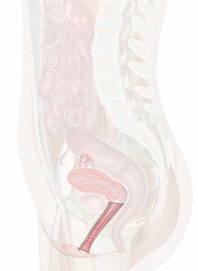The Vagina
Learn about the anatomy and function of the vagina with Innerbody's 3D illustrations.

The vagina is an elastic, muscular tube connecting the cervix of the uterus to the vulva and exterior of the body. The vagina is located in the pelvic body cavity posterior to the urinary bladder and anterior to the rectum. Measuring around 3 inches in length and less than an inch in diameter, the vagina stretches to become several inches longer and many inches wider during sexual intercourse and childbirth. The inner surface of the vagina is folded to provide greater elasticity and to increase friction during sexual intercourse.
The inner lining of the vagina is made of non-keratinized stratified squamous epithelial tissue. This tissue provides protection from friction to the underlying layers of the vagina. Watery secretions produced by the vaginal epithelium lubricate the vagina and have an acidic pH to prevent the growth of bacteria and yeast.
The acidic pH also makes the vagina an inhospitable environment for sperm, which has resulted in males producing alkaline seminal fluid to neutralize the acid and improve the survival of sperm.
Deep to the epithelial layer is the lamina propria, a layer of connective tissue with many elastin fibers that allow the vagina to stretch. A layer of smooth muscle tissue located deep to the lamina propria allows the vagina to expand and contract during sexual intercourse and childbirth. Surrounding the smooth muscle is the outermost layer of the vagina known as the tunica externa. The tunica externa is a layer of dense irregular connective tissue that forms the outer protective shell of the vagina.
During sexual intercourse, the vagina functions as the receptacle for the penis and carries sperm to the uterus and fallopian tubes. The elastic structure of the vagina allows it to stretch in both length and diameter to accommodate the penis. During childbirth, the vagina acts as the birth canal to conduct the fetus from the uterus and out of the mother's body. Once again, the vagina's elasticity allows it to greatly increase its diameter to accommodate the fetus. Finally, the vagina provides a passageway for menstrual flow from the uterus to exit the body during menstruation.
















